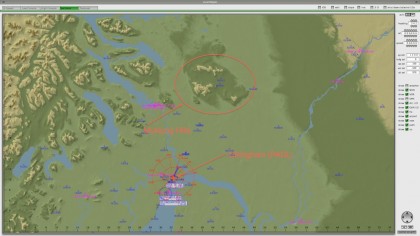By now everyone’s heard about the crash. I’d thought I’d give my complete and thoroughly amateur analysis of what happened with the flight that killed former Senator from Alaska, Ted Stevens. Some have expressed surprise that Senator Stevens was in a plane crash previously, in which his first wife was killed. While aircraft disasters are not common anywhere else, they are as common as car crashes are to us if you’re talking about Alaska. Airline pilot is erroneously listed as one of the most dangerous professions. Being a commercial airline pilot is not really any more dangerous than most desk jobs. The numbers are skewed by the fact that being a bush pilot in Alaska is really dangerous. The planes are small, weather is fickle, and there’s a lot of things to run into at altitudes bush pilots generally fly at. The most common cause of aircraft fatalities in Alaska is controlled flight into terrain. This is technical speak for crashing into a friggin’ mountain. It’s easy to do in Alaska. Stevens’ plane didn’t crash into a mountain by Alaska standards; it crashed into hills. The plane was operating under Visual Flight Rules, and flew into bad weather around the Muklung Hills. The pilot tried to take the DeHavilland DHC-3T to a higher altitude to avoid the hilltops, but came up short and crashed into them.
You can see from this sectional chart, showing the ultimate destination at Dillingham, AK, and the Muklung Hills, that there’s definitely not much in the way of navigational beacons in this area. Dillingham is pretty much it, and it only provides a VOR and a localizer to find the runway. It does not provide for a glideslope beacon. This would not be an airport you’d want to fly into in foul weather. To give you some idea just how bad flying in Alaska is in these kinds of conditions, I fired up X-Plane with today’s weather conditions in that area. The time is about 2:00PM locally, and flying is a challenge, to put it mildly.
And the plane I chose is easier to fly than the amphibious plane Senator Stevens was on. It has a modern navigation and avionics system, and can climb at a considerably higher rate of speed, even though it’ll get tossed around in the weather a lot. You can see flying in Alaska under these kinds of conditions is hazardous even for professional pilots who know what they are doing. Newsweek, being the classy publication that it is, tries to hint that Senator Stevens engineered his own demise by not allowing regulators to have their way with Alaskan Aviation. While I’m sure the folks at Newsweek, who know nothing of aviation, would probably love to believe that the right kind of liberal bureaucrats in Washington can, of course, make flying in Alaska perfectly safe, the fact of the matter is that Alaska is dangerous country. The state motto really ought to be changed to “Alaska: It’ll F***ing kill you!” If the seas don’t get you, the skies and mountains will, and if you live through that, you better hope the rescue folks find you before the grizzlies or polar bears do. Senator Stevens lived to be 86, and died living the way Alaskans want to live. Newsweek can go to hell.


One point you missed, about flying in AK, is the sheer vastness of empty wilderness. This can turn a crash you might be able to walk away from, in a more populated area into a fatal one.
Greg’s right… like the bush pilot, back when planes were very new. Crashed in the wilderness, only thing broke was the propeller. He was fine, but would die because he was too far from anything.
So he cut down a tree, carved a new propeller, and flew off again.
Our bush pilots are crazy in the awesome way.
Carving your own propellor is definitely crazy in the awesome way :)
Its terrible
RIP Sen. Stevens.
This kind of thing illustrates the absurdity of taking the experience of living in a densely-populated urban area and assuming that something that would be a pretty good idea in one environment would have much use in another. A lot of “safety” regs that operate at the margins in one area are completely pointless in another because the margin of safety that they add moves the chance of rescue from 80% to 88% might move the chance of successful rescue in another from 8% to 8.8%…
Horses for courses